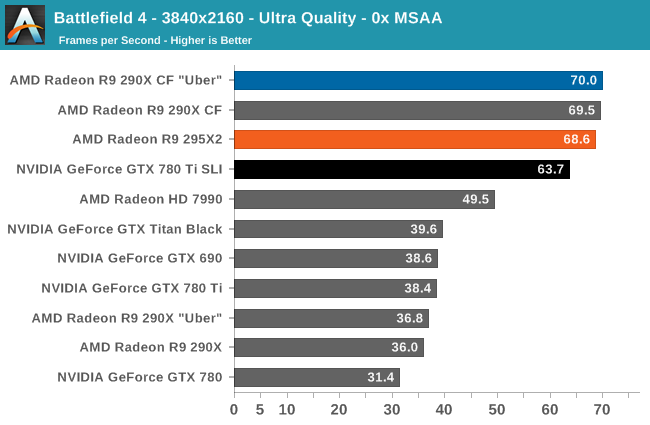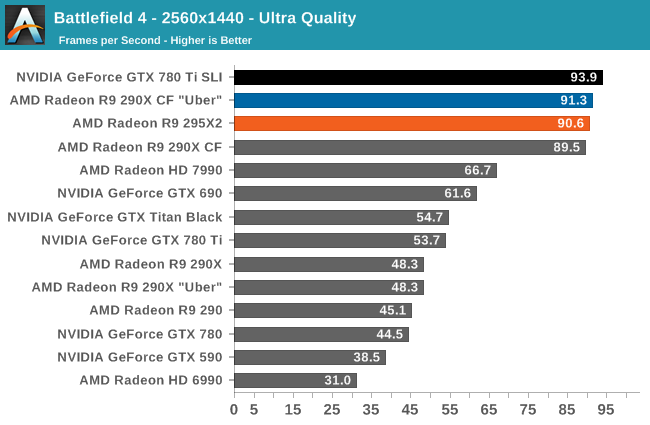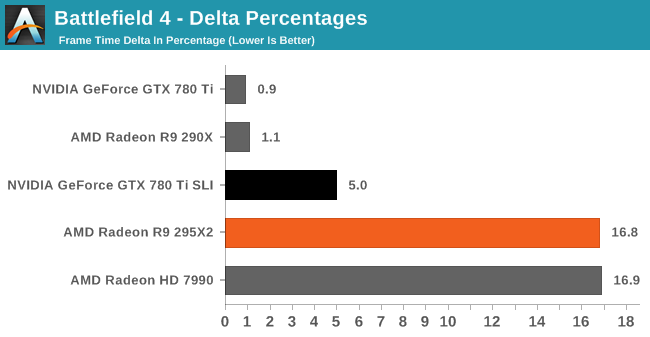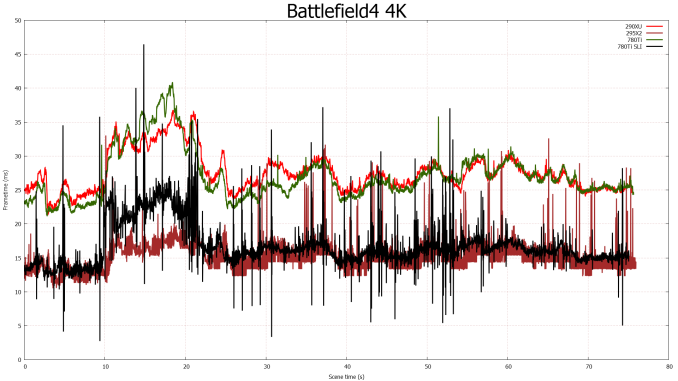The AMD Radeon R9 295X2 Review
by Ryan Smith on April 8, 2014 8:00 AM EST- Posted in
- GPUs
- AMD
- Radeon
- Radeon 200
Battlefield 4
Our current major multiplayer action game of our benchmark suite is Battlefield 4, DICE’s 2013 multiplayer military shooter. After a rocky start, Battlefield 4 has finally reached a point where it’s stable enough for benchmark use, giving us the ability to profile one of the most popular and strenuous shooters out there. As these benchmarks are from single player mode, based on our experiences our rule of thumb here is that multiplayer framerates will dip to half our single player framerates, which means a card needs to be able to average at least 60fps if it’s to be able to hold up in multiplayer.



As is the case in a few of our other games, whether it’s AMD who’s winning or NVIDIA who’s winning depends on the resolution. At 2160p with Ultra settings (and no MSAA) it’s AMD on top, with the 295X2 capable of delivering 68fps. This is safely past the 60fps threshold needed to ensure that minimum framerates don’t drop below 30fps in multiplayer. Otherwise at 1440p the NVIDIA GTX 780 Ti SLI setup pulls ahead, however the 295X2 is right on its tail.
In the meantime this game is also a good example of just how much faster than the 7990 the 295X2 is, despite the fact that both products are based on high-end (for their time) 28nm GPUs. The 295X2 ends up being over 40% faster at both 2160p and 1440p, showing just how far AMD has come in single card dual-GPU performance in the last year.


Shifting to our delta percentage benchmarks, we once more find that the 295X2 has no problem staying within the 20% threshold needed for smooth frame pacing. Though overall NVIDIA does hold an edge, especially at 1440p.












131 Comments
View All Comments
mickulty - Wednesday, April 9, 2014 - link
Well, Arctic's 6990 cooler wasn't far off. The arctic mono is good for 300W and it should be possible to fit two such heatsinks on one card. So it's possible. The resulting card would be absolutely huge though, and wouldn't be nearly as popular with gaming PC boutiques (IE the target market).Oh, VRM cooling might be an issue too. I guess a thermaltake-style heatpipe arrangement would fix that.
SunLord - Tuesday, April 8, 2014 - link
Huh looking at that board and layout of the cooling setup you can swap in two independent closed looped coolers pretty easily and try and overclock it if you want and since your rich if you buy this it's totally viable for any ownernsiboro - Tuesday, April 8, 2014 - link
Ryan, thank you for a wonderfully written and informative review. Appreciate much.behrouz - Tuesday, April 8, 2014 - link
Ryan Smith , Please Confirm this :The new nv's Driver Does Overclock GTX 780 Ti, From 928 to 1019Mhz.if So Temp should be increased.
behrouz - Tuesday, April 8, 2014 - link
and also Power ConsumptionRyan Smith - Tuesday, April 8, 2014 - link
Overclock GTX 780 Ti? No. I did not see any changes in clockspeeds or temperatures that I can recall.PWRuser - Tuesday, April 8, 2014 - link
I have a Antec Signature 850W sitting in the closet. 295X2 too much for it?It's this one: http://www.jonnyguru.com/modules.php?name=NDReview...
Dustin Sklavos - Tuesday, April 8, 2014 - link
Word of warning: do not use daisy-chained PCIe power connectors (i.e. one connection to the power supply and two 8-pins to the graphics card). If AMD wasn't going over the per-connector power spec it wouldn't be an issue, but they are, which means you can melt the connector at the power supply end. Those daisy-chained PCIe connectors are meant for 300W max, not 425W.We've been hearing about this from a bunch of partners and I believe end users should be warned.
PWRuser - Tuesday, April 8, 2014 - link
Thank you. According to specs my PSU could handle these GPU separately, I guess utilizing 2 PCIE slots via 2 separate cards alleviates the strain.extide - Tuesday, April 8, 2014 - link
No it has nothing to do with how many cards or slots. It's how many CABLES from the PSU.Sometimes you can have a single cable with two pcie connectors on the end, one daisy chained of the other. What he is saying is, don't use connectors like that, use two individual cables instead.
Although, unless the PSU you are using has really crappy (thin) power cables, it should be OK even with a single cable. But yeah, it's definitely a good idea to use two!